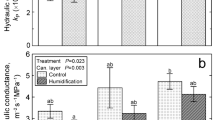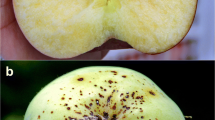Abstract
Studies were conducted on the effects of seasonal levels of relative humidity, temperature, and total radiation, on dry weight of petals, on fresh weight of epicuticular wax and of cuticle of petals, on numbers ofBotrytis cinerea lesions in petals, and on preharvest flowering periods in gerbera and rose. No temporal relationships or significant correlations were found among dry weight of petals, weight of wax and cuticle of petals, and numbers of lesions on the petals. Temperature, relative humidity and total radiation did not correlate significantly with dry weight of petals, or with fresh weights of wax and cuticle of petals, except for a positive correlation between relative humidity and cuticle weight in the gerbera cultivar Delphi. No relation was found between weight of epicuticular wax and cuticle of petals and susceptibility of gerbera and rose petals toB. cinerea. The thickness of wax and cuticle on flowers did not seem to be an important factor influencing the susceptibility of flowers toB. cinerea. The seasonal pattern in number of lesions produced on the flowers byB. cinerea was related to the effects of relative humidity and radiation on infectivity of conidia of the pathogen on the flower surface but not to the effects on the susceptibility of flowers.
Similar content being viewed by others
References
Aist JR (1976) Cytology of penetration and infection-Fungi. In: Heitefuss R and Williams PH (eds) Physiological Plant Pathology (pp. 197–221) Springer-Verlag, Heidelberg
Baker EA (1974) The influence of environment on leaf wax development inBrassica oleracea var.gemmifera. New Phytologist 73: 955–966
De Jong JTh (1985)Botrytis cinerea, een plantaardige veelvraat. Vakblad voor de Bloemisterij 33: 28
De Jong JT. (1986) Grauwe Schimmel de grootste schadeveroorzaker. Vakblad voor de Bloemisterij 31: 12–13
Faretra F and Antonacci E (1987) Production of apothecia of Botryotinia fuckeliana (de Bary) Whetz. under controlled environmental conditions. Phytopathologiamediterranea 26: 29–35
Holloway PJ and Baker EA (1968) Isolation of plant cuticles with zincchlorid-hydrochloricacid solution. Plant Physiology 43: 1878–1879
Kerssies A (1993) Influence of environmental conditions on dispersal ofBotrytis cinerea conidia and on post-harvest infection of gerbera flowers grown under glass. Plant Pathology 42: 754–762
Kerssies A (1994) Effects of temperature, vapor pressure deficit and radiation on infectivity of conidia ofBotrytis cinerea and on susceptibility of gerbera petals. European Journal of Plant Pathology 100: 123–136
Kerssies A, Bosker-van Zessen AI and Frinking HD (1995) Influence of environmental conditions on dispersalof Botrytis cinerea conidia and on post-harvest infection of rose flowers grown under glass. European Journal of Plant Pathology 101: 200–216
Kolattukudy PE (1985) Enzymatic penetration of the plant cuticle by fungal pathogens. Annual Review of Phytopathology 23: 223–250
Köller W (1991) Plant cuticles: The first barriers to be overcome by plant pathogens. In: Cole GT and Hoch HC (eds.) The Fungal Spore and Disease Initiation in Plants and Animals. (pp. 219–246) Plenum Press, New York
Louis D (1963) Les modalités de la pénétration duBotrytis cinerea Pers. dans les plantes. Annales des Epiphyties 14: 57–72
Marois JJ, Redmond JC and MacDonald JD (1988) Quantification of the impact of environment on the susceptibilityof Rosa hybrida flowers toBotrytis cinerea. Journal of the American Society for Horticultural Science 113: 842–845
Martin JT (1964) Role of cuticle in the defense against plant disease. Annual Review of Phytopathology 2: 81–100
Nicholson RL and Epstein L (1991) Adhesion of fungi to the plant surface: prerequisite for pathogenesis. In: Cole GT and Hoch HC (eds.) The Fungal Spore and Disease Initiation in Plants and Animals (pp. 3–23) Plenum Press, New York
Payne RW, Lane PW, Ainsley AE, Gower JC, Tunnicliffe-Wilson G and Paterson LJ (1987) GENSTAT 5: Reference Manual. Clarendon Oxford, Science Publications 749 pp
Potter C (1952) An improved laboratory apparatus for applying direct sprays and surface films, with data on the electrostatic charge on atomized spray fluids. Annals of Applied Biology 39: 1–28
Salinas J, Glandorf DCM, Picavet FD and Verhoeff K (1989) Effects of temperature, relative humidity and age of conidia on the incidence of spotting on gerbera flowers caused byBotrytis cinerea. Netherlands Journal of Plant Pathology 95: 51–64
Salinas J (1990) Protection of gerbera flowers against infection ofBotrytis cinerea with anticutinase monoclonal antibodies. Acta Botanica Neerlandica 39: 313–314
Silva Fernandez AM, Baker EA and Martin JT (1964) Studies on plant cuticle. VI. The isolation and fractionation of cuticular waxes. Annals of Applied Biology 53: 43–58
Skoss JD (1955) Structure and composition of plant cuticle in relation to environmental factors and permeability. Botanical Gazette 117: 55–72
Stockwell V and Hanchey P (1984) The role of the cuticle in resistance of beans toRhizoctonia solani. Phytopathology 74: 1640–1642
Van den Ende G and Linskens HF (1974) Cutinolytic enzymes in relation to pathogenesis. Annual Review of Phytopathology 12: 247–258
Author information
Authors and Affiliations
Rights and permissions
About this article
Cite this article
Kerssies, A., Frinking, H.D. Relations between glasshouse climate and dry weight of petals, epicuticular wax, cuticle, pre-harvest flowering period and susceptibility toBotrytis cinerea of gerbera and rose flowers. Eur J Plant Pathol 102, 257–263 (1996). https://doi.org/10.1007/BF01877964
Accepted:
Issue Date:
DOI: https://doi.org/10.1007/BF01877964




